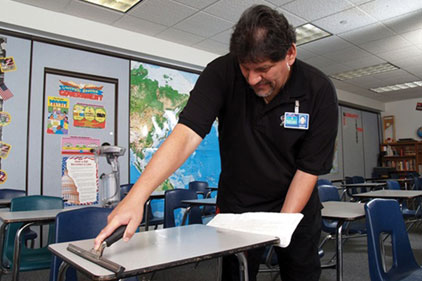The Cleaning Industry Research Institute (CIRI) has worked for years with the world’s largest association representing the cleaning industry, conducting research that led to a new way to evaluate the effectiveness of cleaning schools: the ISSA Clean Standard: K-12.
Document what you do
It is critical to first define what is currently being done. In the cleaning for health arena, this step alone can lead to major improvements. That is why the Clean Standard: K-12 recommends a comprehensive initial audit of the building and cleaning practices. Write it down. What supplies are used for what activities? How often? Using what methods or equipment? Who does it?
Safety and health pros are in a great position to learn about and use the resources in the Clean Standard in order to perform better building audits. They can efficiently employ the visual audit and sampling tools in the standard that provide crucial baseline information. Having a safety or health professional conduct such an audit also helps to keep important facility documentation in the same location. Documentation like safety inspections, maintenance records, safety data sheets, emergency planning, industry contacts, training logs, and more can be bundled as appendices to the overall building cleaning audit.
This baseline is then dissected to find ways to improve on existing cleaning procedures, if necessary. The comprehensive visual assessment of all areas of the facility goes from classrooms to boiler rooms, hallways to restrooms, cafeterias to offices.
Test what you do
|
Utilizing the Clean Standard involves both a visual assessment and measurements. Twice a year, while school is active but after cleaning is done for the day, each space is inspected for visual evidence of its overall condition, visible soil, apparent damage, odor, and many more subjective observations. The need for follow-up is noted and prioritized on a standard form. The summary of the individual spaces is collected in a lead document that serves as an accountability tool, as well. Also noted at this time are other significant observations that may affect safety, operation, and security aspects that go beyond the primary goals of the janitorial assessment but are critical to a well-run facility.
Research has produced a documented standard for several types of surfaces that are found in all school facilities. These surface types are all “high touch points,” by way of which disease is commonly passed. A relatively small number of representative samples are used for each particular building, but after tens of thousands of samples being collected by some of the nation’s leading researchers on cleaning and contamination, these surfaces have been found to be best suited to consistently assess the effectiveness of a cleaning program in a school.
Evaluate what you do
ATP swabs and meters are a staple of environmental safety and health programs in the food service, healthcare, and even restoration industries. An assessor following the Clean Standard: K-12 uses numerous adenosine triphosphate (ATP) swabs to sample a percentage of each surface type throughout the school, and a palm-sized luminometer provides a numerical indication of surface cleanliness for each swab in less than a minute. The Clean Standard instructs the assessor to tabulate the scores, average them, and then compare the average with the suggested numerical values. Since the most common ATP meters do not utilize a standard scale, various tables are presented in the standard so that any of the meters can be used. By comparing these measurements to a defined standard, the custodial team knows how far they need to go to attain effective cleaning practices. The safety and health professional that is trained by the Cleaning Industry Research Institute International (CIRI) as a supervisor/assessor works through the information gathered to develop appropriate recommendations for improved cleaning.
As with all safety and health investigations, the goal of the Clean Standard program is not to point fingers. Many elements go into a successful cleaning program: people, training, time, equipment, chemicals, frequency, and methods, to name a few. When the measurements and the visual assessment together suggest that changes are necessary, the results will be based on fact-finding, not fault-finding.
Improve what you do
Once the visual and measured assessment is complete and evaluations are made and the grade is shared, suggested improvements are defined. Then you implement those corrections. Make sure the changes are fully understood by everyone involved, with the proper chemicals, training, time, and equipment in place. Once changes are implemented, a new assessment should be conducted to confirm the effectiveness of the new processes.
Extraordinary becomes ordinary
The Clean Standard is one that safety and health professionals should investigate and adopt (http://www.ciriscience.org/training-certification.php). Multiple studies have shown that effective surface cleaning can reduce sick days, improve productivity and mental acuity for the occupants, and even save money by identifying and incorporating the most efficient practices for normal cleaning. There are up-front costs for training, an ATP meter, and implementation of documentation, but like many good safety and health programs, the pay-off follows close behind.





